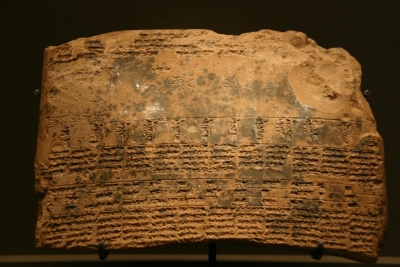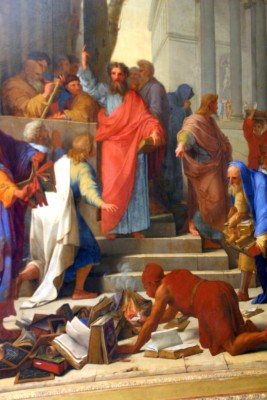Un jour, Une Œuvre,
14/01
Zodiac Calendar AO 6448 Richelieu room 3 showcase 15 (27) This tablet was part of a work comprising twelve volumes, each one studying a sign of the zodiac.
The reverse shows a woman holding an ear of corn; this is the constellation known as the ‘Furrow’ (Virgo). In the centre, an eight-pointed star is identified by its inscription as the planet Mercury. To the left is the Corvus (the raven or crow) constellation. The bird is pecking at the end of Hydra’s tail, belonging to the previous sign. Note the division into twelve boxes, each corresponding to a month of the year.
Astrology comes of Babylonian religious practices.
There is strong evidence that the zodiac
was formed at Babylon around 2100 BCE.
Several of the ancient constellation figures
have a remarkably Babylonian character, and nearly
all may be explained from Babylonian mythology. Morris Jastrow
Western astrology is a
direct descendant of Babylonian
religious practices
Within a short space of time, astrology was to hold a prominent place in worship and the art of divination. The Sun, the Moon and the planets were considered the home of the gods. The planet Jupiter was identified with Marduk, Venus with Ishtar, Saturn with Ninurta, Mercury with Nebi and Mars with Nergal. The priests, later called mathematici, believed that the exact interpretation of the movements of these celestial bodies revealed the intentions of the gods. A181, A182
The zodiac was formed at Babylon around 2100 BCE
“Divination ‘through writing’ was typically Mesopotamian, and we have been left with numerous vestiges of this, [...] from the beginning of the second millennium. The only ones with knowledge of this divinatory code were professional diviners called baru – the ‘examiners’ –
because their role was to scrutinise unexpected or abnormal events or objects in order to decipher them and read the fragments of the future the gods had inscribed in them.” Jean Bottéro In the days of the Prophet Daniel,
astrology was so widespread in Chaldea (Babylonia) that ‘ Chaldeans ’ was practically synonymous
with ‘ astrologists ’ (Daniel 4:7; 5:7, 11). Daniel was witness to the inability of these ‘priest-magicians’ to predict the fall of Babylon. Note that Isaiah 47:13
had announced two centuries earlier
with a hint of irony: =>
Since its beginnings,
astrology has been associated
with religion. A183
“Save you, the worshipers of the heavens, the lookers at the stars, those giving out knowledge at the new moons concerning the things that will come upon you. ”
- Isaiah 47:13, 14
Saint Paul Preaching At Ephesus Inv 8020 LE SUEUR Sully 2nd floor, room 19 Each year on 1 May, the Goldsmiths' Guild of Paris presented Notre-Dame Cathedral with a large painting. This masterpiece is the
most famous.
Saint Paul Preaching At Ephesus
Western astrology is a direct descendant of Babylonian practices. Is it a Christian art? The first disciples of Ephesus wanted no association with this practice. A184 We can read that “quite a number of those who practiced magical arts brought their books together and burned them up before everybody.” - Acts 19:19.

